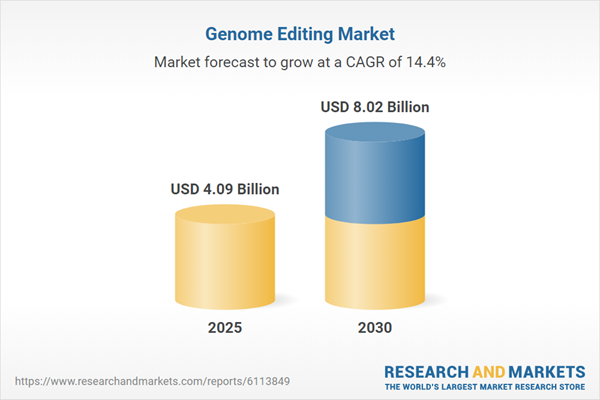Genome editing, a transformative technique for altering an organism’s DNA, is pivotal in agriculture, healthcare, and research. Its applications include enhancing crop yields, diagnosing and treating diseases, and advancing scientific discovery. The global genome editing market has experienced significant growth driven by increasing incidences of cancer and genetic disorders, rising investments, and supportive government policies. This summary, tailored for industry experts, focuses on key market drivers and geographical trends based on developments from 2024 onward, excluding earlier data as requested.
Market Drivers
Rising Prevalence of Cancer and Genetic Disorders
The global increase in cancer and genetic disorders continues to propel demand for genome editing solutions. The International Agency for Research on Cancer (IARC) projects a significant rise in cancer cases, with Europe expecting an increase from 4.398 million in 2020 to 5.323 million by 2040 (a 21% rise) and North America anticipating growth from 2.557 million to 3.525 million (a 38% increase) over the same period. In Asia, cancer cases are forecasted to surge by over 59% by 2040. These alarming trends underscore the urgent need for innovative treatments, positioning genome editing as a critical tool for developing targeted therapies. The identification of new genetic disorders further amplifies this demand, as researchers leverage genome editing to address complex conditions, driving market expansion.Increased Investments and Research
Investments in genome editing have surged, fueled by its potential to address agricultural and healthcare challenges. Governments worldwide are actively supporting these advancements. For instance, in 2024 and beyond, the UK government has continued to streamline regulations to facilitate research and development in genome editing for agriculture, aiming to enhance crop productivity and ensure safe market entry for genome-edited products. Similarly, China’s government has prioritized CRISPR-based innovations to bolster food security, building on significant prior investments. These efforts are complemented by global research initiatives, which are expected to further accelerate market growth by fostering innovation and expanding applications of genome editing technologies.Geographical Outlook
North America’s Market Leadership
North America is poised to maintain a dominant share of the global genome editing market, driven by substantial investments in research and development. The region’s robust infrastructure, coupled with a strong focus on addressing rising cancer and genetic disorder cases, supports its leadership position. Collaborative efforts between academic institutions, biotech firms, and government agencies continue to advance genome editing applications, ensuring North America’s prominence in the market.Asia Pacific’s Rapid Growth
The Asia Pacific region is expected to experience significant market growth, propelled by increasing healthcare expenditures and the rising prevalence of genetic disorders and cancer. China’s extensive use of CRISPR technology, supported by government-backed initiatives, is a key driver of this growth. The region’s focus on improving healthcare outcomes and agricultural productivity through genome editing positions it as a critical growth hub in the global market.The genome editing market is on a robust growth trajectory, driven by the escalating need for advanced treatments for cancer and genetic disorders, increased global investments, and supportive government policies. North America leads due to its investment landscape, while the Asia Pacific region is emerging as a high-growth area, particularly with China’s advancements in CRISPR. These trends highlight genome editing’s transformative potential, making it a focal point for industry innovation and investment through 2040.
Key Benefits of this Report:
- Insightful Analysis: Gain detailed market insights covering major as well as emerging geographical regions, focusing on customer segments, government policies and socio-economic factors, consumer preferences, industry verticals, and other sub-segments.
- Competitive Landscape: Understand the strategic maneuvers employed by key players globally to understand possible market penetration with the correct strategy.
- Market Drivers & Future Trends: Explore the dynamic factors and pivotal market trends and how they will shape future market developments.
- Actionable Recommendations: Utilize the insights to exercise strategic decisions to uncover new business streams and revenues in a dynamic environment.
- Caters to a Wide Audience: Beneficial and cost-effective for startups, research institutions, consultants, SMEs, and large enterprises.
What do businesses use our reports for?
Industry and Market Insights, Opportunity Assessment, Product Demand Forecasting, Market Entry Strategy, Geographical Expansion, Capital Investment Decisions, Regulatory Framework & Implications, New Product Development, Competitive IntelligenceReport Coverage:
- Historical data from 2022 to 2024 & forecast data from 2025 to 2030
- Growth Opportunities, Challenges, Supply Chain Outlook, Regulatory Framework, and Trend Analysis
- Competitive Positioning, Strategies, and Market Share Analysis
- Revenue Growth and Forecast Assessment of segments and regions including countries
- Company Profiling (Strategies, Products, Financial Information, and Key Developments among others).
Genome Editing Market Segmentation
By Technology Type
- CRISPR
- TALEN
- ZFN
- Others
By Application
- Cell Line Engineering
- Animal Genetic Engineering
- Plant Genetic Engineering
By End-User
- Academic & Research Institutes
- Biotechnology & Pharmaceutical Company
- Contract Research Organization
By Geography
- North America
- USA
- Canada
- Mexico
- South America
- Brazil
- Argentina
- Others
- Europe
- Germany
- France
- UK
- Others
- Middle East and Africa
- Saudi Arabia
- UAE
- Others
- Asia Pacific
- China
- India
- Japan
- South Korea
- Taiwan
- Thailand
- Indonesia
- Others
Table of Contents
Companies Mentioned
- Thermo Fisher Scientific Inc.
- Merck & Co., Inc.
- Horizon Discovery Group plc
- GenScript
- Sangamo Therapeutics, Inc.
- Danaher Corporation
- Lonza Group AG
- BEX Co., LTD.
- OriGene Technologies, Inc.
- CRISPR Therapeutics
Table Information
| Report Attribute | Details |
|---|---|
| No. of Pages | 142 |
| Published | June 2025 |
| Forecast Period | 2025 - 2030 |
| Estimated Market Value ( USD | $ 4.09 Billion |
| Forecasted Market Value ( USD | $ 8.02 Billion |
| Compound Annual Growth Rate | 14.4% |
| Regions Covered | Global |
| No. of Companies Mentioned | 10 |









